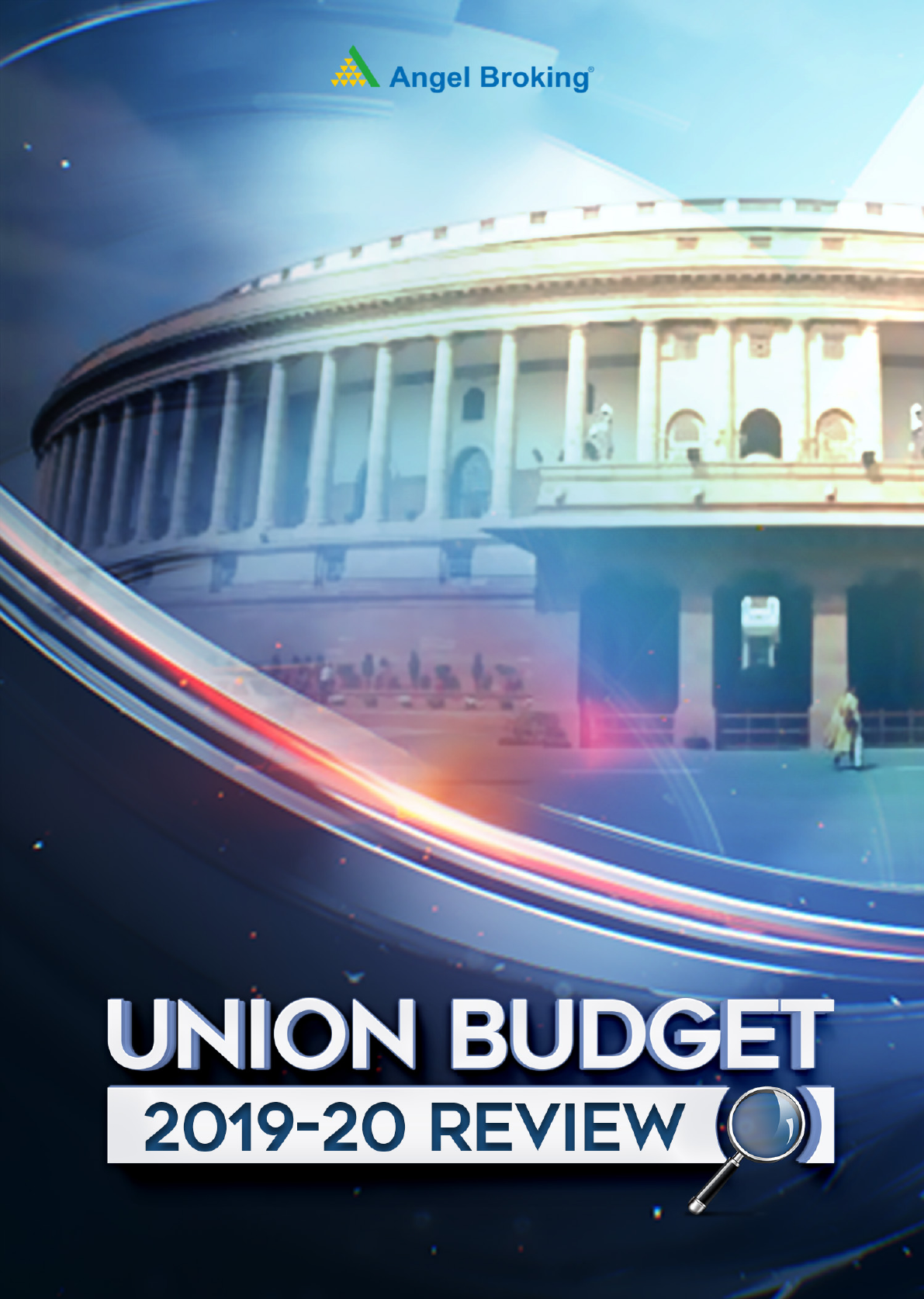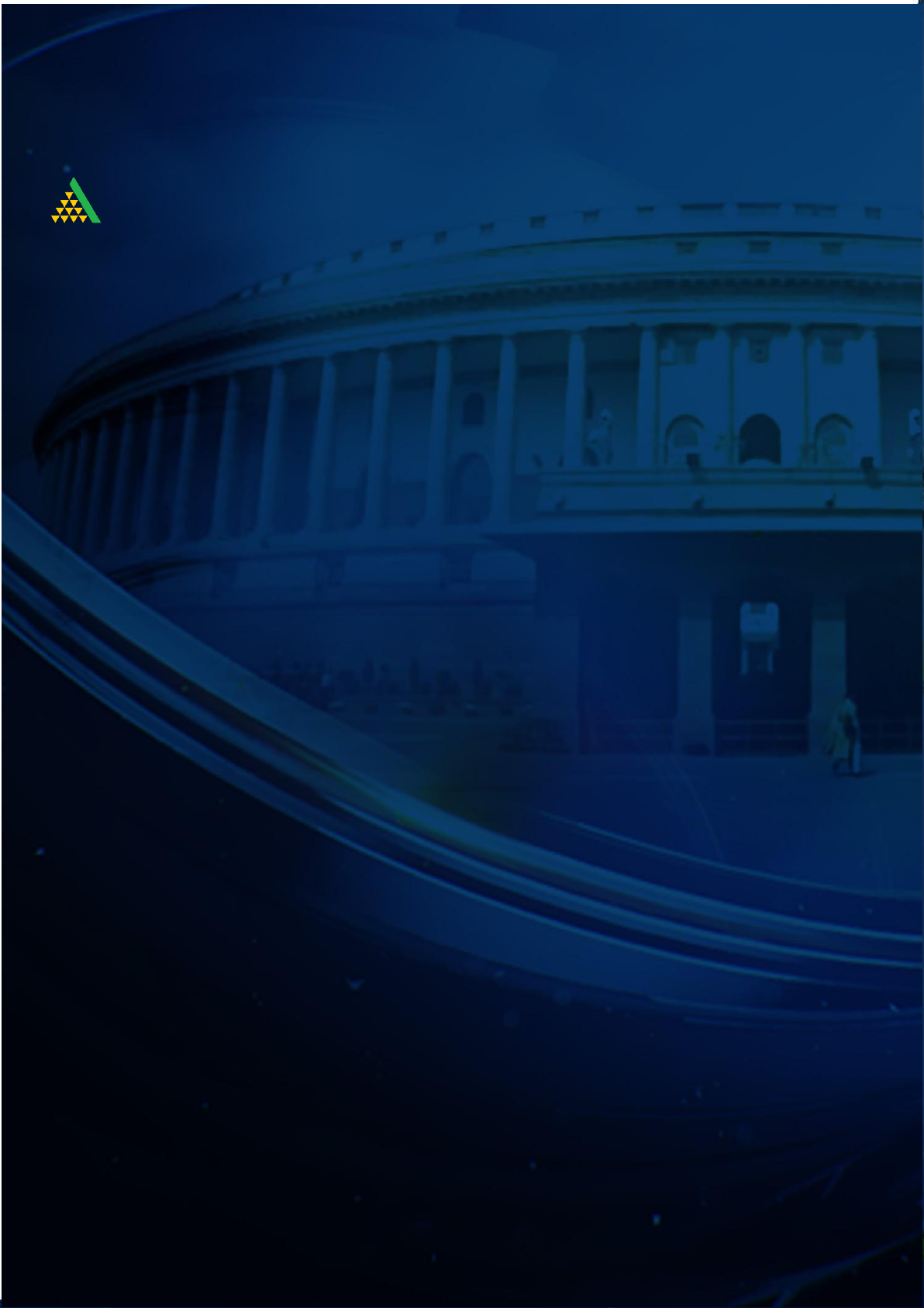

1
Please refer to important disclosures at the end of this report
1
1
Budget 2019 - 20 Review
Government sticks to fiscal deficit target for FY2020
The Government stuck to it’s fiscal deficit target for FY2020 despite a significant
shortfall in revenues collections for FY19. Gross tax revenues for FY19 fell way
short of expectations at ` 20.8 lakh cr. as compared of revised target of ` 22.5
lakh cr. As a result net tax revenue came in short at ` 13.17 lakh cr. as compared
to revised estimates of ` 14.84 lakh cr.
The Government stuck to the interim budget fiscal deficit figure of ` 7.03 lakh cr.
for FY2020 in the final budget, though relying more on non tax revenues and
disinvestment proceeds in order to make up for the shortfall in tax revenues. While
the fiscal deficit for FY2020 in absolute numbers was maintained at ` 7.03 lakh cr.
upward revisions in GDP numbers for FY2020 resulted in the fiscal deficit falling to
3.3% against 3.4% of GDP as projected in the interim budget.
The NBFC sector had also been going through a crisis post the collapse of IL&FS
and was unable to extend credit. The Government has announced a slew of policy
measures for the NBFC sector in order to address the liquidity issues faced by the
sector, including a one time six months partial credit guarantee given to banks to
buy pooled asset of NBFCs. PSU bank recapitalization of ` 70,000 cr. would also
provide growth capital to the banking sector.
Higher Government spending to stimulate growth in FY2020
Given the slowdown in growth post the IL&FS crisis there was a significant
slowdown in tax collection in FY19. It was largely expected by the markets that the
Government would resort to cut back in expenditure in FY2020 due to lower tax
collections. However given the increased social outlay in FY20 and thrust on rural
economy it was evident that there was much that the Government could do to cut
back revenue expenditure.
Therefore in a way it is not surprising that Government maintained expenditure in
line with the interim budget estimates of ` 27.9 lakh Cr. which represents a growth
of 20.5% over FY2019. Revenue expenditure is budgeted to grow 21.9% to ` 24.5
lakh cr. while capital expenditure is budgeted to grow at 11.8% to ` 3.4 lakh cr.
which is again in line with the interim budget. In order to budget for the higher
spending the Government has resorted to hikes in both direct as well as indirect
taxes.
On the direct tax front surcharge for individuals earning between ` 2 - 5 cr. has
been proposed increased from 15% to 25%. Similarly for individuals earning
above ` 5 cr. surcharge has been proposed to be increased from 15% to 37%.
This is expected to augment personal income tax collection which had fallen
significantly short of estimates in FY19.
On the indirect tax front the Government has also hiked taxes on petrol and diesel
which is by ` 2 each and also increased import duties on many commodities.
These measures are expected boost indirect tax collections given sluggish growth in
GST collections.
Fiscal deficit for FY2019 at 3.4%, while
fiscal deficit for FY2020 was revised
down to 3.3%.
Various policy measures announced to
address liquidity issues faced by the
NBFC sector.
Government trying to stimulate the
economy by significant increase in
expenditure by 20.5% in FY2020.
Surcharge on Income tax to be hiked
significantly for individuals in highest
tax brackets.

2
Please refer to important disclosures at the end of this report
FY20 Fiscal deficit target is challenging though achievable
Borrowing figures for FY20 have been kept at the same level as that of the interim
budget. Both gross and net borrowing figures have been kept unchanged at
`4.73 lakh cr, and `7.6l lakh cr in FY2020.
Gross tax collections for FY2020 are expected to grow at 18.3% yoy against a
growth of 8.4% in FY2019. Net tax collections are expected to grow at 25.3% in
FY2020 given that devolution to states are expected to grow by 6.0%. Direct taxes
are expected to grow by 18.6% yoy driven by personal income tax which is
budgeted to grow by 23.3% yoy while corporate taxes are expected to grow by
15.4% yoy.
Indirect tax collections are expected to grow by 17.9% yoy which is well ahead of
GDP estimates of 11.2% yoy. GST collections are expected to grow by 13.6% yoy.
With GST collections struggling to pick up growth in indirect tax collections are
expected to be driven by excise and customs duties which are expected to grow by
29.9% and 32.2% respectively.
Non-tax revenue are expected to grow by 27.2% yoy predominantly driven by
Dividend and profit receipts from PSU’s and the RBI. It seems that the Government
is factoring in marginal transfer of some surplus reserves from the RBI in the
budget estimates. Disinvestment targets for FY2020 has been revised higher to
`105,000 cr. from `90,000 cr.in the interim budget.
Revenue growth for FY2020 seems to be aggressive and there is a possibility of
shortfall in tax collections in FY2020. Tax increases proposed by the Government
in the budget is likely to provide buoyancy to tax collections. However transfer of
surplus RBI reserves to the Government would help the Government in meeting
fiscal deficit target in case there is any shortfall in tax collections.
Exhibit 1: Key Fiscal indicators ( % of GDP)
% of GDP
FY18A
FY19RE
FY19A
FY120BE
Gross Tax Revenue
11.2%
12.0%
10.9%
11.7%
Devolution t o State s
3.9%
4.1%
4.0%
3.8%
Net Tax to Centre
7.3%
8.0%
6.9%
7.8%
Direct Taxes
5.9%
6.4%
5.9%
6.3%
Indirect taxes
5.4%
5.6%
5.0%
5.3%
Capital Receipt (ex borrowing)
0.7%
0.5%
0.5%
0.6%
Revenue Expenditure
11.0%
11.5%
10.6%
11.6%
Subsidie s
1.3%
1.6%
1.6%
1.6%
Total Capital Expenditure
1.5%
1.7%
1.6%
1.6%
Total Expenditure
12.5%
13.2%
12.2%
13.2%
Revenue Deficit
2.6%
2.2%
2.3%
2.3%
Fiscal Deficit
3.5%
3.4%
3.4%
3.3%
Primary Deficit
0.4%
0.3%
0.3%
0.2%
Source: Budget documents, Angel Research
Budget 2019 - 20 Review

3
Please refer to important disclosures at the end of this report
Exhibit 2: Budget 2019-20 at a glance
Particular
Budget (` cr)
YOY (%)
FY18A
FY19RE
FY19A
FY20BE
FY19A
FY20BE
(A) Revenue Receipts (1+2)
14,35,233
17,29,882
15,63,170
19,62,761
8.9
25.6
Gross Tax Revenue (a+b)
19,19,009
22,48,175
20,80,203
24,61,195
8.4
18.3
Devolution to States/Trf to NCCD
6,73,006.0
7,61,454.0
7,63,252
8,09,133
13.4
6.0
%
35.1%
33.9%
36.7%
32.9%
1) Tax Revenue (Net to Centre)
12,42,488
14,84,406
13,16,951
16,49,582
6.0
25.3
a) Direct Taxe s
10,01,974
12,00,000
11,25,220
13,35,000
12.3
18.6
Income Tax
4,30,772
5,29,000
4,61,650
5,69,000
7.2
23.3
Corporate Tax
5,71,202.0
6,71,000
6,63,570
7,66,000
16.2
15.4
b) Indirect taxes
9,16,972
10,48,175
9,54,983
11,26,195
3.9
17.9
Custom Duties
1,29,030
1,30,038
1,17,930
1,55,904
-8.6
32.2
Excise Duties
2,59,431
2,59,612
2,30,900
3,00,000
-11.0
29.9
Service Tax
81,228
9,283
6,880
0
-91.5
-100.0
GST
4,42,562
6,43,900
5,83,970
6,63,343
32.0
13.6
Others
4,721
5,342
15,303
6,948
224.1
-54.6
2) Non Tax Revenue
1,92,745
2,45,476
2,46,219
3,13,179
27.7
27.2
(B) Capit al Receipts (3+4+5)
7,02,649
6,86,352
7,48,252
7,72,529
6.5
3.2
3) Recovery of Loans
15,633
13,155
17,840
14,828
14.1
-16.9
4) Disinvestment
1,00,045
80,000
85,045
1,05,000
-15.0
23.5
5) Borrowings and Other Liabilities
5,86,971
5,93,197
6,45,367
6,52,702
9.9
1.1
Total Receipt(A+B)
21,37,882
24,16,234
23,11,422
27,86,349
7.9
20.5
(C)Revenue ex penditure
18,78,835
21,40,611
20,08,463
24,47,780
6.9
21.9
6) Of which interest payments
5,28,951
5,87,570.0
5,82,675
6,60,471
11.1
13.4
(D) Capital expenditure
2,63,140
3,16,624
3,02,959
3,38,569
15.1
11.8
Total Expenditure (C+D)
21,41,975
24,57,235
23,11,422
27,86,349
7.9
20.5
(E) Fiscal Deficit (C+D-A-3-4)
5,91,064
6,34,198
6,45,367
7,03,761
9.2
9.0
(F) Revenue Deficit (C-A)
4,43,602
4,10,729
4,45,293
4,85,019
0.4
8.9
(G) Primary Deficit (E -6)
5,91,064
46,628
62,692
43,290
-6.9
-30.9
GDP
1,70,95,000
1,86,52,882
1,90,10,200
2,11,00,607
11.2
11.0
Fiscal Deficit (% of GDP)
3.5%
3.3%
3.4%
3.3%
Source: Budget documents, Angel Research
Budget 2019 - 20 Review

4
Please refer to important disclosures at the end of this report
Subsidy Burden to remain stable
Since BJP came into power in 2014, the subsidies have been falling as a % of GDP
due to couple of favorable factors like falling prices of oil and fertilizers raw
material, coupled with reforms in agriculture sector like DBT and regularization of
Urea pricing. Subsidies as a % of GDP has come down from 2.2% of GDP in
FY2014 to 1.6% of GDP in FY19. In the final budget subsides are estimates to gow
by 13.3% yoy to ` 3,38,949 cr. which is more or less in line with the interim
budget estimates of ` 334,235 cr. Small increment is on account of ` 5010 cr. of
additional fertilizer subsidies.
Exhibit 3: Subsidy
Subsidy Break-down
FY15
FY16
FY17
FY18
FY19RE
FY20BE
Major Subsidies
2,49,016
2,41,857
2,32,705
1,91,183
2,66,206
301,694
Fertilizer Subsidy
71,076
72,438
70,000
66,441
70075.2
749996
yoy gr owth (%)
6%
1.9%
-3.4%
-5.1%
0.0%
14.2%
Food Subsidy
1,17,671
1,39,419
1,35,173
100281
171298
184220
yoy gr owth (%)
28%
18.5%
1.0%
-25.8%
1.2%
7.5%
Petroleum Subsidy
60,269
30,000
27,532
24,461
24833.2
37478
yoy gr owth (%)
-29%
-50.2%
-8%
-11.2%
-0.4%
50.9%
Interest Subsidy
7,632
13,808
18865
22,146
22676.6
25056.0
yoy gr owth (%)
-6%
80.9%
4%
17.4%
-1.7%
10.5%
Other Subsi dy
1,610
2,136
3,128
11,099
10327.6
12199.5
yoy gr owth (%)
-9%
32.7%
46%
254.8%
27.5%
18.1%
Total Subsidy
2,58,258
2,57,801
2,54,698
2,24,429
2,99,211
3,38,949
yoy gr owth (%)
1%
-0.2%
-1%
-11.9%
1.3%
13.3%
% to GDP
2.0%
1.8%
1.7%
1.3%
1.6%
1.6%
Source: Budget documents, Angel Research
Government trying to stimulate economy through Farm package,
spending and liquidity measures
The government surprised the market and did not go for any major tax cuts in
the budget. With this budget the Government has made its intentions clear
that they will try and spend their way out of the economic slump rather than
go for tax cuts in order to stimulate the economy.
Increased social outlays in FY2020 through various Government scheme like
the PM-KISAN would ensure additional income in the hands of the poorest of
the poor. This would go a long way in supporting rural income and boosting
growth.
The budget also tried to address the liquidity issues faced by the NBFC sector
through various policy measures. PSU bank recapitalization of ` 70,000 cr.
would also ensure that PSU banks are in a position to extend credit to industry.
Budget 2019 - 20 Review

5
Please refer to important disclosures at the end of this report
Sectoral Impact
Budget 2019 - 20 Review

6
Please refer to important disclosures at the end of this report
Agriculture Positive
Announcement
Fishery focused scheme - Pradhan Mantri Matsya
Sampada Yojana (PMMSY) was introduced to establish a
robust fisheries management framework. It will address
critical gaps in the value chain, including infrastructure,
modernization, traceability, production, productivity, post-
harvest management, and quality control.
Impact
Positive for fishery industry, as PMMSY scheme shall
boost income for fishermen and shall also improve
productivity due to superior infrastructure development.
Stocks like Avanti Feeds stands to benefit from this.
Automobile Positive
Announcement
To make electric vehicle affordable to consumers, the
government has proposed to provide additional income
tax deduction of ` 1.5 lakh on the interest paid on loans
taken to purchase electric vehicles. This amounts to a
benefit of around ` 2.5 lakh over the loan period to the
taxpayers who take loans to purchase electric vehicle.
Increase in customs duty in the range of 2.5-7.5% on
various auto ancillary equipments like Glass mirrors, rear
view mirrors, locks, lighting or visual signaling, horns,
windscreen wipers, Completely Built Unit (CBU), etc.
Reduction in customs duty on parts exclusively used for
Electric vehicles like E-drive assembly, on board charger,
E-compressor, Charging Gun to zero.
Impact
This will be positive for the electric vehicle manufacturer
companies like Tata Motors and M&M
This would be positive for domestic auto ancillary
equipment manufacturers.
Positive for all electric vehicle manufacturers.
Budget 2019 - 20 Review

7
Please refer to important disclosures at the end of this report
Banks & Financial Services (BFSI) Positive
Announcement
The Fiscal deficit for FY2020 has been reduced by 10bps
to 3.3% of GDP and government has kept gross
borrowings unchanged. The government also proposed
to raise some part of borrowing through global bond
markets.
Continuing with its focus to realize the goal of 'Housing
for All' by 2022, (1) 1.95cr houses are proposed to be
provided to eligible beneficiaries under PMAY-Grameen;
(2) The interest deduction limit has increased by
`1,50,000 to `3,50,000 for self occupied properties on
loans borrowed up to March 31, 2020 and purchase
value of up to `45 lakh.
`70,000cr capital infusion in public sector banks
NBFCs will not have to maintain debenture redemption
reserve (DDR) for debt raised through public issue. One
time six months partial credit guarantee given to banks to
buy pooled asset of NBFCs.
Interest on certain bad or doubtful debts by deposit-
taking as well as systemically important non-deposit
taking NBFCs to be taxed in the year in which interest is
actually received.
Impact
This will reduce crowding out effect in domestic market
and ease G-Sec yield.
Positive for Housing Finance Companies such as GIC
Housing, CanFin Homes, Gruh Finance, PNB Housing.
Positive for PSU banks, as they will be able to meet
regulatory requirement and step up lending activity.
Positive for NBFCs (STFC, AB Capital, Piramal Ent., etc.),
as these steps will help them to improve their liquidity
position.
Positive for NBFC
Ceramic Positive
Announcement
Increase in customs duty on ceramic roofing tiles, ceramic
flags and hearth or wall tiles, etc. from 10% to 15%.
Impact
Positive for domestic ceramic companies like Kajaria
Ceramics, Asian Granite, Somany Ceramics, etc.
Budget 2019 - 20 Review

8
Please refer to important disclosures at the end of this report
Consumption discretionary Negative
Announcement
Increase in customs duty on indoor and outdoor unit of
split system air conditioner from 10% to 20%.
Impact
Negative for Air Conditioner manufacturers like Voltas,
Blue Star, etc. However, we believe industry would pass
on the hike to consumers.
FMCG Negative
Announcement
Removal of custom duty exemption on palm oil & other
industrial fatty acids used in manufacturing of soaps.
Custom duty of 7.5% is proposed to be levied.
Impact
Imposition of custom duty on Palm Oil shall effect
companies like Godrej consumer which uses palm oil as
raw material in manufacturing soaps.
Infrastructure/Cement/ Real Estate Positive
Announcement
Government under the Pradhan Mantri Gram Sadak
Yojana (PMGSY) aims to upgrade 1.25 lakh kms of rural
roads over the next five years with an outlay of ` 80,250
cr.
Government has highlighted their intent to invest over `
100 lakh crore in Infrastructure over the next 5 years.
Government looking to develop inland waterways under
the Jal Amrg Vikas project which will ease movement of
goods in the domestic market.
The interest deduction limit has increased by `1,50,000
to `3,50,000 for self occupied properties on loans
borrowed up to March 31, 2020 and purchase value of
up to `45 lakh..
Impact
Positive for Infrastructure (Road) companies and cement
companies such as Ultractech, ACC, Shree Cement, Star
cement, etc.
Positive for Logistics companies like container
corporation and companies involved in developing
inland waterways like dredging corporation
Positive for real estate companies like Sobha Developers
who cater to the affordable housing segment.
Jewellery Negative
Announcement
Increase in customs duty on gold from 10% to 12.5%.
Impact
Negative for Jewellery companies like Titan Company,
PC Jeweller, TBZ, etc. It will increase overall cost of
jewellery, which will result in negative sentiment in
consumers
Budget 2019 - 20 Review

9
Please refer to important disclosures at the end of this report
Paper Positive
Announcement
Increase in customs duty on Newsprint from 0% to 10%.
Impact
Positive for domestic paper companies like Tamil Nadu
Newsprint & Paper.
Textile Positive
Announcement
Reduction in customs duty on wool fibre & wool tops
from 5% to 2.5%.
Impact
This would be positive for textile companies like Monte
Carlo Fashions.
Others Positive
Announcement
Pradhan Mantri Awas Yojana – Gramin (PMAY-G) aims
to achieve the objective of “Housing for All” by 2022. A
total of 1.54 crore rural homes have been completed in
the last five years. In the second phase of PMAY-G,
during 2019-20 to 2021-22, 1.95 crore houses are
proposed to be provided to the eligible beneficiaries.
Impact
It would create demand for steel, cement and other
building materials. This will be positive for companies in
these sectors.
Budget 2019 - 20 Review

10
Please refer to important disclosures at the end of this report
Research Team Tel: 022 - 39357800 E-mail: research@angelbroking.com Website: www.angelbroking.com
DISCLAIMER
Angel Broking Limited (hereinafter referred to as “Angel”) is a registered Member of National Stock Exchange of India Limited,
Bombay Stock Exchange Limited, Metropolitan Stock Exchange Limited, Multi Commodity Exchange of India Ltd and National
Commodity & Derivatives Exchange Ltd It is also registered as a Depository Participant with CDSL and Portfolio Manager and
Investment Adviser with SEBI. It also has registration with AMFI as a Mutual Fund Distributor. Angel Broking Limited is a reg istered
entity with SEBI for Research Analyst in terms of SEBI (Research Analyst) Regulations, 2014 vide registration number INH000000164.
Angel or its associates has not been debarred/ suspended by SEBI or any other regulatory authority for accessing /dealing in securities
Market. Angel or its associates/analyst has not received any compensation / managed or co -managed public offering of securities of
the company covered by Analyst during the past twelve months.
This document is solely for the personal information of the recipient, and must not be singularly used as the basis of any investment
decision. Nothing in this document should be construed as investment or financial advice. Each recipient of this document sh o uld
make such investigations as they deem necessary to arrive at an independent evaluation of an investment in the securities of the
companies referred to in this document (including the merits and risks involved), and should consult their own advisors to de termine
the merits and risks of such an investment.
Reports based on technical and derivative analysis center on studying charts of a stock's price movement, outstanding positions and
trading volume, as opposed to focusing on a company's fundamentals and, as such, may not match with a report on a company's
fundamentals. Investors are advised to refer the Fundamental and Technical Research Reports available on our website to evaluate the
contrary view, if any
The information in this document has been printed on the basis of publicly available information, internal dat a and other reliable
sources believed to be true, but we do not represent that it is accurate or complete and it should not be relied on as such, as this
document is for general guidance only. Angel Broking Limited or any of its affiliates/ group companies shall not be in any way
responsible for any loss or damage that may arise to any person from any inadvertent error in the information contained in th is report.
Angel Broking Limited has not independently verified all the information contained within this document. Accordingly, we cannot
testify, nor make any representation or warranty, express or implied, to the accuracy, contents or data contained within this document.
While Angel Broking Limited endeavors to update on a reasonable basis the information d iscussed in this material, there may be
regulatory, compliance, or other reasons that prevent us from doing so.
This document is being supplied to you solely for your information, and its contents, information or data may not be reproduc ed,
redistributed or passed on, directly or indirectly.
Neither Angel Broking Limited, nor its directors, employees or affiliates shall be liable for any loss or damage that may ari se from or in
connection with the use of this information.
Ratings (Based on expected returns Buy (> 15%) Accumulate (5% to 15%) Neutral (-5 to 5%)
over 12 months investment period): Reduce (-5% to -15%) Sell (< -15)
Budget 2019 - 20 Review

Angel
Broking
®
(
J\R
Q
6th Floor, Ackruti Star, Central Road, MIDC, Andheri(E), Mumbai - 400 093. Tel: (022) 39357800
Research Team
Fundamental:
Vaibhav Agrawal
Amarjeet S Maurya
Jaikishan Parmar
Jyoti Roy
Head of Research & ARQ
Analyst (Mid-Caps)
Analyst (BFSI)
Analyst (Strategy)
vaibhav.agrawal@angelbroking.com
amarjeet.maurya@angelbroking.com
jaikishan.parmar@angelbroking.com
jyoti.roy@angelbroking.com
Technical and Derivatives:
Sameet Chavan
RuchitJain
Rajesh Dashrath Bhosle
Sneha Seth
Chief Technical & Derivative Analyst
Technical Analyst
Technical Analyst
Derivatives Analyst
sameet.chavan@angelbroking.com ruch
it.jain@angelbroking.com
rajesh.bhosle@angelbroking.com
sneha.seth@angelbroking.com
Discl aim er: 'Investm en ts in se curi ties m ark et ar e su bje ct to m ark et risk, r ead al l t he re lat ed do cu me nts car efully befo re inv es tin g.'
Ang el Br oki ng Li mit ed (for merly k now n as Ang el Br oki ng Priva te Li mit ed), R egis ter ed O ffice: G - 1, A ckr uti Tra de C ent er, R oad N o. 7, M IDC,
A n dh e ri ( E), M u m b ai - 4 0 0 0 9 3. T el: ( 02 2) 3 0 8 3 7 7 00 . Fa x : ( 0 22) 28 3 5 8 8 1 1, CI N: U 6 7 12 0 MH 1 9 9 6P L C1 0 1 7 09 , SE BI R e g n. N o. :
INZ0001 615 34- BSE C ash/F&O/ CD (M e mbe r I D: 6 12), N SE C ash/F &O/CD (M e mb er ID: 127 98), M SEI Cas h/F&O /C D (M em be r ID : 10 50 0), M CX
Com mo dity Der ivatives (M em ber I D: 126 85) a nd N CDEX Co m mod ity D eriva tives (M e mb er ID: 22 0), C DSL Reg n. N o .: IN-DP -38 4-2 01 8, P M S
Reg n. N o.: IN P00 000 15 46, R esea rc h Ana lyst SEBI Re gn. No.: INH 0 000 00 164 , Inv estm en t Advise r SEBI Re gn. No. : INA 00 000 81 72, A M FI
R e gn . N o. : ARN- 7 7 4 04 . Co m p li a n ce off ic e r: Ms . Na m i ta G od b ol e , T el: (0 2 2) 3 9 4 1 39 4 0 E m ai l: c o m pli a n c e@ a n ge l br o ki n g. c o m